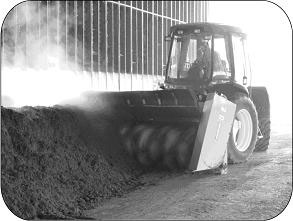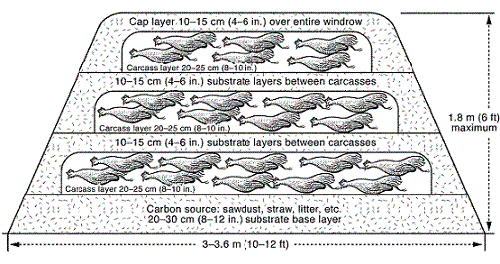



Windrow Composting of Poultry Carcasses
By Al Dam (Provincial Poultry Specialist), Bill Groot Nibbelink (Livestock Regulatory Affairs Specialist) and Daniel Ward (Engineer, Poultry Structures and Environment), all from Ontario Ministry of Agriculture, Food And Rural Affairs (OMAFRA).Poultry producers in Ontario currently have several options for managing dead birds on their operations, including pick-up by a licensed deadstock company, burial, incineration and composting. This Factsheet describes the critical elements needed to successfully compost poultry carcasses using the windrow method. A windrow compost pile is a long, narrow pile of biodegradable organic matter, with a large surface area that allows for good oxygen infiltration (Figure 1).

Compost is produced through the decomposition of biodegradable organic matter by aerobic micro-organisms (that require oxygen to survive) into a stable, soil-like material called humus. To encourage this rapid decomposition, it is necessary to provide the optimal environment for these micro-organisms to thrive and multiply.
The Recipe
The microorganisms require the correct mix of carbon, nitrogen, oxygen and water to operate. The recipe — the blending of the correct ratios of raw materials during windrow formation — is one of the key steps to successful composting.
According to literature, the optimum recipe will have a carbon-to-nitrogen (C:N) ratio of between 20:1 and 30:1. This means there will be between 20–30 units of carbon, by mass, for every unit of nitrogen present. The optimum moisture content of the recipe is 40-60%. The materials must be blended or piled to allow for oxygen to infiltrate the pile — materials should not be compacted in a compost pile.
Substrate Materials
Fresh poultry carcasses contain approximately 80% moisture, 12% carbon and 2.4% nitrogen, and have a C:N ratio of 5:1 by weight. The carcasses by themselves are deficient in carbon and too wet to compost, so additional carbon material (substrate) must be added to the mix. Different substrate materials have different chemical and physical properties (Table 1). These differences are managed by mixing different amounts of various substrate materials with the carcasses to create the optimum recipe.
For example, to compost 909kg (2,000 lb) of poultry carcasses, at least 336kg (740 lb) of sawdust or 2,636kg (5,800 lb) of corn silage would be required to achieve the ideal 30:1 C:N ratio. By volume, this would translate into nearly five times more corn silage than sawdust to achieve the correct ratios.
Table 2 shows the formula for calculating the ideal quantities of different substrate materials to use in a windrow composting pile.
The amount of substrate used in the pile should be determined by the amount needed to achieve the correct C:N ratio. For substrate materials with C:N ratios higher than 80:1, such as sawdust, the amount of substrate required is normally determined by the quantity required to properly cover the carcasses.
The extra carbon in the recipe does not harm the environment. It will translate into higher costs, as more substrate will be used. Rule of thumb: it is always better to have too much carbon in the recipe than too little.
|
Table 1. Common substrate materials and their associated chemical and physical properties.
|
|||||
| Material | % C | % N | C:N ratio | Dry matter | Density |
|---|---|---|---|---|---|
| Sawdust | 56.2 | 0.1 | 511:1 | 61% | 417 kg/m3 (26 lb/ft3) |
| Straw | 56 | 0.7 | 80:1 | 82% | 80 kg/m3 (5 lb/ft3) |
| Corn silage | 43.8 | 1.0 | 44:1 | 30% | 688 kg/m3 (43 lb/ft3) |
| Horse manure | 44.3 | 1.5 | 30:1 | 39% | 592 kg/m3 (37 lb/ft3) |
| Poultry litter | 120 | 8.0 | 15:1 | 60% | 320 kg/m3 (20 lb/ft3) |
The Compost Pile
The final pile is cone-shaped, 2.4–3.6m (8-12 feet) wide at the base and 1.2-1.8m (4-6 feet) tall at the highest point (Figure 2). No poultry carcasses should be visible in the finished windrow; during the creation of the pile, carcasses are placed at least 15cm (6 inches) from the edges of the pile. The cap is extremely important as it serves as a biofilter to reduce or contain odours within the windrow during carcass breakdown.
Release of odours is not only offensive to neighbours, it can attract scavengers, such as skunks, raccoons, rats and coyotes, to the compost windrow. Due to the prolonged heating of the material, proper composting will destroy most, if not all, of the pathogenic organisms contained in the carcasses. If a scavenger were to remove a partially composted carcass from the windrow pile before the process has been completed, still-active pathogenic organisms could be spread to the surrounding environment — other barns, farms, etc. To maintain biosecurity, any scavenging from the windrows is unacceptable.
Layering Method
Typical windrow formation involves:
- creating a suitable base of substrate 20-30cm (8-12 inches) thick
- adding a layer of birds
- adding an additional 10-15cm (4-6 inches) of substrate
- adding another layer of birds, possibly a third layer of substrate and third layer of birds (depending on the equipment to be used to “turn”the material)
- capping the entire pile with 10-15cm (4-6 inches) of substrate (Figure 2)
Mix-and-Build Method
The mix-and-build method involves:
- establishing a base of substrate, also 20-30 cm (8-12 inches) thick
- creating a mix pile of bird carcasses and the required amount of substrate with a front-end loader, adjacent to the windrow location
- scooping up and depositing this blended material on top of the base
- capping the entire pile with substrate as in the layering method
|
Table 2. Calculating how much substrate material to use.
Formula: |
| 30 = [(weight x % C x % dry matter) of Material A + (weight x % C x % dry matter) of Material B] ÷ [(weight x % N x % dry matter) of Material A + (weight x % N x % dry matter) of Material B] |
| Sample calculation (for sawdust and 908 kg (2,000 lb) of carcasses): |
| 30 = [(weight of sawdust x 56.2% x 61%) + (908 kg (2,000 lb) of carcasses x 12% x 20%)] ÷ [(weight of sawdust x 0.1% x 61%) + (908 kg (2,000 lb) of carcasses x 2.4% x 20%)] |
| 30 = [((weight of sawdust) x 3,248) + 480,000] ÷ [((weight of sawdust) x 6.1) + (96,000)] |
| ((weight of sawdust) x 183) + 2,880,000 = ((weight of sawdust) x 3,248) + 480,000 |
| 2,400,000 = ((weight of sawdust) x 3,245) |
| 335.78 kg (739.6 lb) = weight of sawdust |
| For every 908 kg (2,000 lb) of poultry carcasses, you need 336 kg (740 lb) of sawdust to reach the target 30:1 C:N ratio. |

Moisture
The other key ingredient in the recipe is moisture. The microorganisms will thrive if the moisture content of the pile is 40-60%. If a pile is too dry to reach optimum conditions, water may be added. If a pile is too wet, additional “dry” substrate is added to absorb the excess moisture, or the pile can be aerated.
When a pile is too wet, leachate can drain from the windrow, or offensive odours can be generated from it (aerobic microorganisms are unable to survive in these conditions, so their anaerobic counterparts take over the process, producing odorous by-products). Using corn silage can have this effect, as it is quite wet and blending it with fresh carcasses would result in a mixture that is 65-75% moisture (40-60% is ideal).
When fresh poultry carcasses are used, there is usually no need to add extra moisture, as there is a lot of moisture in the birds themselves. Only if the substrate is extremely dry (>85% dry matter) or the carcasses have dried out before the windrow was created should a pile need water added.
Composting can be done inside a building or outside, however, it is much easier to manage the composting process if the pile is under cover of a roof, to prevent the addition of moisture from precipitation. If the pile cannot be under a roof, locate the compost site away from sensitive features, such as wells, surface water or other land uses, e.g., neighbouring houses, and use a compost recipe with a drier substrate, factoring in some additional moisture absorption.
Managing the Compost Pile
If all the ingredients are present in the correct combination, the microorganisms will quickly start to decompose the organic matter and generate heat that can be measured using a thermometer or a thermocouple. Monitoring the temperature of compost piles is one of the best ways to determine whether the process is working properly (Figure 3).

It is not uncommon for the core of the pile to reach temperatures of 50-65°C or higher, which is important for the destruction of pathogenic organisms in the organic matter. Research has shown that the avian influenza (AI) virus can be inactivated at 60°C in 10 min or 56°C in 90 min (Lu et al., 2003). These high temperatures also discourage insects such as maggots or Rove beetles from inhabiting the windrows.
The management of a compost pile involves periodically re-introducing oxygen into the materials by mixing the pile, maintaining aerobic conditions in the pile for the microorganisms. The mixing also ensures that the materials are reorganized within the pile to encourage rapid decomposition of the remaining organic material. Generally, after the initial formation of the compost pile, the material will heat up quickly and then gradually start to cool down. The cooling down is normally a sign that the organisms are starting to be deficient in one of the ingredients, usually oxygen. Mixing or stirring the pile reintroduces oxygen, so the microorganisms become active again, causing the compost pile temperatures to rise once more (Figure 4).
Equipment used to “turn” the windrows varies from specialized compost turning equipment (Figure 1) to front-end loaders used to re-pile the material.
Recent experience in Ontario with end-of-lay hens has shown that temperatures in the windrows peaked 5-10 days after the windrows were created, depending on the substrate used (straw substrate peaked in 5 days), then started to gradually decline. Most substrate mixtures were initially turned after 12-21 days. Temperatures increased in the pile once more before gradually declining.

Thirty days after the windrow was created, the most active composting process was complete, and there was little evidence of poultry carcasses in the material apart from the odd bone (skull, thigh bone etc.), which was extremely brittle due to the high heat exposure. There were no feathers or flesh present in the material, which looked more like topsoil than the original substrate material.
The compost continued to produce heat, indicating that it was still curing. A second turning of the material can help to speed this curing process by introducing more oxygen into the pile. The finished product can be applied to crop land as soil amendment similar to using livestock manure to fertilize crops.








